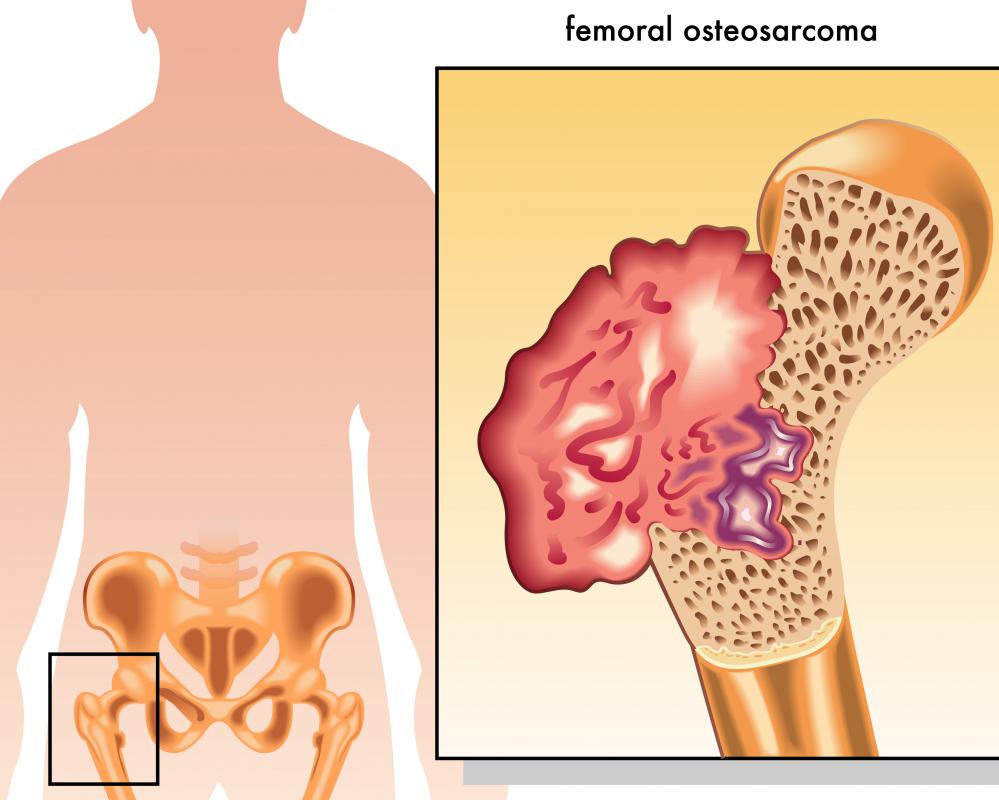At TheHealthBoard, we're committed to delivering accurate, trustworthy information. Our expert-authored content is rigorously fact-checked and sourced from credible authorities. Discover how we uphold the highest standards in providing you with reliable knowledge.
What is Osteosarcoma?
Osteosarcoma is a malignant tumor that grows inside bones. It is often thought of as a childhood cancer because 65% of all cases occur in adolescents between the ages of 14 and 16. Osteosarcoma is a serious form of cancer, and though treatment has improved, the survival rate is still alarmingly low.
In roughly 80% of the cases, osteosarcomas grow in and around the knee. The tumors are made up of the same tissue as bone, but are much weaker. Early detection is rare, though some evidence of a connection between certain forms of eye cancer in children, called retinoblastoma, and osteosarcoma has been established. If the patient has had retinoblastoma, any symptoms that might indicate osteosarcoma, for example pain in the leg that worsens at night, should be screened early to detect the presence of bone tumors.

In many cases, however, there is no known cause for an osteosarcoma. Symptoms, generally mild at first, like leg pains, are quite common in all children. Should leg pain develop into limping, or if the area around the leg seems swollen, not as the result of a direct injury, medical advice should be sought. Early detection through x-ray, magnetic resonance imaging (MRI), and computed tomography (CT) scans; along with biopsy of any tumors found, significantly improves survival rate. Unfortunately, no test exists to screen patients at onset because generally symptoms at onset are mild.

The earlier the detection of this cancer, the less chance the cancer has to metastasize and form tumors in the lungs or in other bones. Osteosarcoma, once diagnosed, is classified in stages. A localized osteosarcoma has not spread and is affecting only the bones and muscles it touches. Metastatic osteosarcoma has spread to other parts of the body. In over 75% of of metastatic osteosarcoma cases, tumors develop in the lungs.

Numbers can also be assigned to stages. For example, stage one osteosarcoma is a small, non-metastasized tumor. Stage two is a larger tumor that has not yet metastasized. Stage three means the tumor has spread to other types of the bone, and stage four means the cancer has spread to the lungs. Survival at stage four depends upon whether tumors in the lungs can be surgically removed.

Treatment of osteosarcoma depends on stages. If a single stage one or stage two sarcoma is detected, a doctor of oncology will prescribe chemotherapy as the first step in an effort to shrink the existing tumor and hopefully prevent metastasis. If the tumor shrinks, an orthopedic surgeon then removes it. In some cases, the only successful means of removal is through amputation of the limb.

There are .3 cases of osteosarcoma per 100,000 people. Of those affected, one third will die in the first year. Those least at risk will present with stage one or stage two sarcomas. Therefore, anyone who notices symptoms such as those listed above should seek his or her physician's advice. Parents should be particularly vigilant of such symptoms in their adolescent children.
AS FEATURED ON:
AS FEATURED ON:


















Discussion Comments
@LauraLynn: My son, age 13, had an osteosarcoma in his foot. Apparently this is an extremely rare place for it to occur. Which bone was yours in? His was a metatarsal bone. He had it removed and is on two monthly check ups for the first year. Luckily, when it is in the foot or hand, it has a higher cure rate. Hope everything has gone well for you.
Too early to tell Laura-Lynn. A ct can only suggest, a biopsy is the one. I'm going through the same thing: outside left foot, two x-rays, two bone scans, one CT scan,which all were very easy to go through, and now another ct scan and biopsy where they at the same time take a sample by needle. I don't care. I just want the pain gone. Good luck.
I'm 27 and just got diagnosed with stage 2 Osteosarcoma in my left foot. Currently i'm in a cast for pain management and having a CT scan done in two weeks and a biopsy! My Sarcoma is being linked to a previous surgery I had as a kid called Bilateral Tarsal Coalition. I still have awful pain in my leg and foot at night. Walking seems unbearable at times. I'm nervous about all of this, but im sure I will be fine!
Osteosarcoma doesn't always affect children, I am now 54 years old and started with a severe pain in my right heel back in December 1999,It wasn't till I had a below knee Amputation in October of 2002 that It was discovered that the Tumor was in fact Ostesarcoma.I am due to go back hopefully for my last check up in August where I will then get the all clear.My advice to any one suffering any form of pain in the lower limbs is to get medical advice as soon as possible and demand an X-Ray if the pain is serious.Don't let your GP fob you off with excuses such as Arthritis or problems with the Plantar if the pain is in the feet.
Post your comments